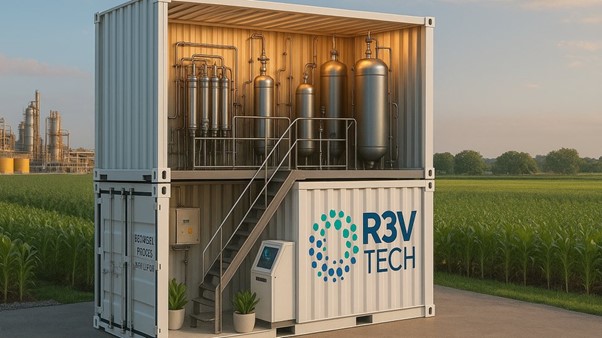The chemical industry could tackle problems related to energy efficiency and productivity using integrated motor-drive systems, says Ghanshyam Shrestha, R&D Technology Manager at ABB IEC Low Voltage Motors.
The chemical industry is foundational. It supplies the world with essential materials for everything from pharmaceuticals to critical materials to fertilisers. But the modern world’s reliance on chemicals comes at a cost.
According to the IEA, chemical production is the world’s largest industrial consumer of energy, and with demand growing for petrochemicals and specialty chemicals, pressure on plants to optimise efficiency is at an all-time high, both to reduce costs and stay competitive, and to lessen the impact on the environment.
But chemical production is a marathon run at sprint pace. The demand is enormous and desperate; the process is energy-intensive and hazardous. Depending on the chemical, the risks can be explosive, corrosive, or both. Process control and reliability is therefore even more critical than in other industrial applications.
Pumps, compressors, blowers, and agitators maintain stability in chemical manufacturing processes, and these moving parts is where a lot of energy is likely to be wasted. Many still operate using fixed‑speed induction motors running direct‑on‑line. These legacy motors run at full power whether operations demand it or not, while production is slowed using mechanical controls. Naturally, this wastes energy, but it also induces greater wear on components.
When we factor in volatile electricity prices and tighter environmental and safety regulations, it becomes clear why motor efficiency might be the single most decisive, and most accessible lever for safety, competitiveness and sustainability.
Unique challenges
Like most other industrial sectors, chemical operators work under both common pressures and those that are unique to them.
Reliability and safety are front of mind for chemical manufacturers. Sudden stops and starts from fixed‑speed motors will inevitably strain seals, shafts, and bearings, leading to costly wear and tear. The outcomes are the same as they are in any industrial processing: unplanned downtime and, in the worst cases, a threat to workers’ safety.
On top of this, plants must balance the need for flexibility across both batch and continuous operations. Processes unique to the chemical industry, such as polymerization, resin production, and solvent transfer experience huge swings in terms of load as conditions change. A direct-on-line motor running flat out, even under part‑load conditions, is the equivalent of having your foot all the way down on your car’s accelerator and applying the brake at the same time to control your speed. It’s a massive drain on energy, and a one-way ticket to costly wear and tear.
So, the risk of unplanned downtime is arguably greater in the chemicals industry. Which means the risk, waste generation, and costs associated with unplanned downtime are also greater.
Modernisation, but not as you know it
The simple solution to wear and tear is maintenance, refurbishment and a proactive modernisation strategy. If something is about to break, replace it. However, those very same consequences of unplanned downtime – risk, waste and cost – don’t disappear when the downtime is planned. Efforts to modernise equipment are therefore hard to justify and postponed for this very reason.
Pairing motors with Variable Speed Drives (VSDs) is a proven way to more closely match output to process demand. In a chemical context, this means you can scale solvent transfer pumps to match fluctuating volumes, adjust agitator torque in batch reactors to prevent over‑shearing or product variability, and regulate compressor or blower output in distillation or separation units to reduce peak loads. But despite the proven benefits, adoption of VSDs remains slow and stuttering.
Conventional VSDs require external cabinets, long cable runs, an additional switchgear, and commissioning expertise. Practically speaking, in chemical facilities, where space is at a premium, this is a headache – and extra on-site installation time can deter projects outright.
Breaking down the barriers
Cue the emergence of integrated motor‑drive systems. One such example is our LV Titanium Variable Speed Motor (VSM), which combines an ultra‑efficient permanent‑magnet motor with a matched drive in a single unit. This allows plant operators to simply swap out their motor wholesale, like-for-like in terms of size and space requirements, since there is no external drive cabinet.
In terms of energy and emissions savings, the unit’s IE5 Ultra‑Premium efficiency reduces intrinsic motor losses by up to 40% versus IE3 motors. Coupled with variable‑speed adjustment, the VSM consumes only the power needed at each load stage, thereby cutting operating costs and CO₂ emissions substantially. Pump and agitator applications alone can yield 25–30% energy savings annually.
Integrated platforms reduce footprint by at least two frame sizes, freeing space for process equipment and simplifying site layouts. But there are more benefits to this unification. Enclosed designs naturally resist dust, vapours, and corrosive atmospheres often present in chemical operations. This reduces ingress-related downtime.
The permanent‑magnet motor design means high torque at low speeds, which is especially good for viscous fluids or frequent start-stop duties. And because they come factory-matched, commissioning is easy and compatibility risks that often accompany third‑party modular setups are essentially avoided wholesale.
Scaling energy efficiency gains
The challenges facing the chemical industry – high energy consumption, safety-critical operations, and increasingly strict sustainability expectations – make energy efficiency interventions difficult. Motors, as the largest single energy consumer inside production plants, are the most immediate place to make an impact.










